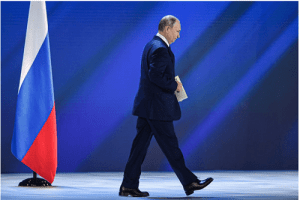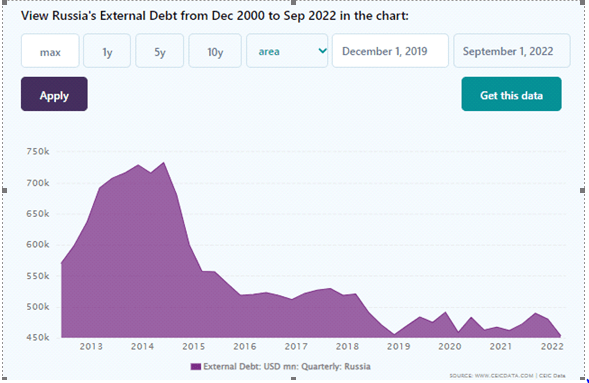 Russia, under President Vladimir Putin, has lost touch with reality. From the war on its eastern border with Ukraine to threatening the European Union with a nuclear war and from the crashing Russian economy to International sanctions, each day, Russia is paying for the crimes of its dictator in-charge. Three decades later, since the demise of the USSR, Russia still overestimates its power in the world and grows more isolated in the modern world. But the question arises what has gone wrong for Putin’s Russia and why the world’s largest country is struggling to survive?
Russia, under President Vladimir Putin, has lost touch with reality. From the war on its eastern border with Ukraine to threatening the European Union with a nuclear war and from the crashing Russian economy to International sanctions, each day, Russia is paying for the crimes of its dictator in-charge. Three decades later, since the demise of the USSR, Russia still overestimates its power in the world and grows more isolated in the modern world. But the question arises what has gone wrong for Putin’s Russia and why the world’s largest country is struggling to survive?

Image Source: ForeignAffaris.com
The economic crisis with a hint of International sanctions:
The Russian economy is in a terrible situation as a result of Western sanctions; the country is currently caught between a recession and stagnation. Although there are proven solutions for the problems now plaguing Russia, but these traditional financial strategies are no longer feasible due to President Vladimir Putin’s geostrategic and political choices.
Russia’s economic struggle and financial instability is not a recent event, but it dates back to the time when it was founded. After the death of the Soviet Union in 1991, a new Russian Federation and regulated economy of Soviet Russia were established under Boris Yeltsin. Following the fall of communism, the Russian Federation underwent several economic changes, including privatization and the freeing up of the market and trade. But even though the economy is far more stable than it was in the early 1990s, inflation is still a problem for Russia.
The Russian economy has gone through two major phases under President Vladimir Putin. Russia saw rapid development from 1999 to 2008, growing by an average of 7% per year. But since 2009, Russia’s economy has stalled, growing only 1% on average yearly.
The global financial crisis of 2008 gave Putin a wake-up call. High and growing oil prices had led rise to the idea of Russia as a world energy superpower, but in 2008, oil prices abruptly fell by 70% (1), and the Russian stock exchange plummeted in parallel. Putin undertook a major bailout of the large state and oligarchic enterprises due to his large cash reserves from oil money, which forced out smaller private businesses. Then followed a decade of economic stagnation and financial instability.
War Economy
Since the Russian people weren’t satisfied with Putin’s economic performance, he chose a small victorious war to exert his power instead, first in Georgia in August 2008 and then the annexation of Crimea in March 2014, and now the full-fledged military invasion of Ukraine in 2022.
However, his invasion of Ukraine sparked severe Western sanctions, including financial ones that went into effect in July 2014 and reduced Russia’s economic growth by 1-1.5 percentage points annually, as well as harsh personal penalties against his closest allies. The Russian economy has been in a state of stagnation since 2014.
The Western financial sanctions caused Russia’s total foreign debt to decrease from $732 billion in June 2014 to $455 billion in December 2018 and reached $436.8 billion in 2022, which restricted investment and consumption in Russia and therefore restrained economic development. (2)

Source: ceicdata.com
On the other hand, Russia’s military expenditures totaled about 65.9 billion current U.S. dollars in 2021, an increase of around 7% over the previous year. Over the course of the observation period, 2013 saw the country’s greatest military spending, totaling more than 88 billion current U.S. dollars. (3)
Economic and financial Sanctions:
Before war, the foreign policy patterns of Russia reflected Putin’s struggle to make Russia a global power. Russia’s increased interest in Latin America and its military adventures in the Middle East are examples of Russian expansion of influence. Russian trade with Latin American countries saw an increase of 44 percent since 2008. However, the war in Ukraine has created many obstacles in Russia’s struggle to garner global influence.
The Western sanctions have been progressively increased as a result of Russia’s recent attack on Ukraine, maintaining its daily fire offensive and refusing to make any changes in its behavior toward Ukraine till its demands are met.
Western nations have been trying to limit Russia’s access to money. They have imposed wide-ranging sanctions on Russia, such as: (4)
- Removal of Russia from the International financial messaging system Swift. Therefore, delaying payments to Russia for its oil and gas imports.
- Assets of Russian officials, oligarchs, entities, and citizens have been frozen in many western countries.
- Ban on oil imports to European Union brought in by sea in E.U. and complete ban on imports of oil and gas from Russia in the USA.
- Ban on all Russian flights from U.S., U.K., E.U., and Canadian airspace.
- Ban on import of Russian gold, with the U.K. imposing a 35% tax on imports from Russia.
These sanctions have proved to be working in constricting Russia’s advancing military extremism and forcing it to halt its invasion of Ukraine. Russia’s ability to fund the war was fueled by its oil and gas reserves which make up 40% of its total exports. A ban on exports of Russian oil and gas will help in ending the war when Russia can no longer afford it.
Russia’s geographical struggle:
Russia’s indefensibility is what makes it vulnerable. Core Russia is restricted to the region that was formerly the historical Grand Principality of Muscovy, in contrast to the centers of other republics, which are relatively defendable. Its borders are not marked by any rivers, oceans, swamps, or mountains; instead, it depends on its forests and generally hostile climate to provide security. Russian history is a record of the suffering suffered while resisting invasion after invasion.
During the Cold War (March 12, 1947 – December 3, 1989), Ukraine, with other neighboring present-day countries of Poland, Romania, Hungary, Austria, and East Germany, served as a “buffer zone” between NATO in the West and Moscow in the East.

Source: Wikipedia
A nation can bleed out any invasion by attrition and attacks on supply lines as long as it holds the territory separating itself from its enemies, even if it is land that is easy for a hostile military to cross. But these buffers include a deadly element. They have populations that may not always be willing to act as a buffer.
In addition to a substantial standing military for defense, maintaining control of such buffers requires a massive internal security and intelligence network to impose central authority. Any institution that is critical to the existence of the state must also be under strict supervision. Establishing these buffer zones not only makes Russia look aggressive to its neighbors but also forces it to terrorize its own institutions in order to maintain the empire.
Just like Russia’s invasion of Ukraine in 2022 has caused Russia a great headache, the reasons for the Soviet collapse were similar. Overextending its armies into Central Europe made it difficult for the Soviet Union to maintain authority while economically exploiting the region. It was a net loss. In addition to the high expense of the military establishment, this overextension resulted in expensive logistical issues.
In order to keep the NATO forces away from the gates of Moscow, controlling east Europe has been on the Russian agenda for over a century. Therefore, Russia has continuously meddled in the politics and stability of Eastern Europe through threats, diplomacy, and dirty political tactics.
The main strategic issue with Russia is its unstable geopolitical position. The Soviet Union and the Russian Empire never experienced true security. Russia’s fundamental economic weakness, brought on by its size and incapacity to transport agricultural products throughout the country, was what caused this. Russia’s inherently poor infrastructure consistently undermines its internal cohesiveness, regardless of how strong its ‘national will’ could be.
Russia’s uphill technological struggle:
For starters, Russia currently dedicates only 1% of its GDP to R&D (research and development), with 70% of the funding coming from public sources and most of it going to public research institutions. (5)
Large corporations conduct just a limited amount of research, and universities are rarely involved, particularly in downstream R&D. The recent output from its science and technology industry is modest for a nation with a rich history of innovation and a strong scientific legacy.
It is well known that innovation and growth go hand in hand. The fact that innovation is the sole source of growth over the long term is one of the few things on which economists can agree. However, in Russia’s case, its stagnant economy doesn’t allow it to allocate a huge budget for technological advancements and research.
Putin’s internal struggle:
Putin’s administration relies on an aggressive foreign policy, military, anti-Western propaganda, and growing living standards to maintain public acceptance and ensure its existence. Given the Kremlin’s rhetoric, the costly and unsuccessful conflict in Ukraine will only increase social and regional unrest.
An accumulation of concerns, such as sharply rising poverty rates, stark socioeconomic inequalities, declining federal financial subsidies, deteriorating local infrastructure, environmental disasters, collapsing healthcare services, widespread official corruption, and public alienation from central decision-making, will cause unrest in many republics and regions. Moscow will be seen as a colonial metropolis that takes advantage of its people more and more.
The Russian Federation may experience a replay of either the Soviet or Yugoslav collapse in the upcoming years or a combination of the two.
Throughout the crisis, the Russian strength remained in its leadership. Putin has been the force that binds Russia together and symbolizes Russian ambitions, character and strength. Questions about a successor or the legacy of Putin had only just emerged before they sunk under the noise of war that seems to have consolidated Putin’s regime once again.
The global public opinion has also swayed against Russia but there are two sides to this narrative as well. While the western narrative pushes that Russian people have been constantly under the influence of Kremlin’s propaganda machine, the western narrative has also been pushed across the world by the NATO and its ally states. However, the world cannot deny the strength of Russia whose sheer size, population and military might can prolong or worsen the war to an extent that cannot only damage the economy of the world but also leave long term climate losses.
Professor Alexander Hill of University of Calgary claims that ‘As far as we can reasonably tell, Putin is here to stay.’ This shows that despite the western coalition against him, Putin has maintained his assertive, strong and unpredictable personality. This is also why Russia’s ambitions to become global power may have become weakened or delayed but cannot be said to have extinguished.
War of narratives:
According to the western narrative, Putin’s regime is fighting on two important fronts. At home the growing frustration among the public due to mass mobilization and economic sanctions and in the field against Ukraine. However, the statistics show that Putin’s popularity has grown in Russia amidst the war. The war may have engaged Putin in a regional quagmire, but his rule may last a lot longer than the western analysts previously speculated.
The Russian economy has been put to test by the heavy sanctions that UK, USA and EU have imposed. These sanctions include the freezing of Russian assets, removing Russian banks from international financial system Swift, and attacking the Russian parliamentarians who are behind the annexation treaties of the four Ukrainian regions. However, Russia has been unable to diversify its economy and the petroleum sanctions are weighing heavy on Putin and Russian public.
Another interesting perspective on the issue was given by a Washington based think tank that claimed that one strategy of Putin could be to keep the West engaged but without considerable show of strength. In this time, the West may think that Putin is no longer a threat and loose their focus from the issue. Which would then give Putin the time and reason to reemerge and continue on his global ambitions.
However, from a different point of view, the above idea of Putin personifying Russian ambitions amount as evidence to his autocratic rule. A popular narrative shaped by the West and supported by majority of the world is whether the war is Russian or Putin’s. This view is based on mounting losses on the Russian side which directly cripple Russian economy and people’s quality of life. In retrospect, after initial aggression, Russia has also suffered losses of its occupied territories in Kyiv region in northern Ukraine, it has also withdrawn from Kharkiv in northeastern Ukraine and most recently from areas of Kherson in southern Ukraine which Putin had claimed to be his ‘forever’.
Unhappy neighbors:
Russia has been considered by the world to be a spoiler in the current conflict with Ukraine and in its previous adventures in Crimea. However, in the Ukrainian conflict Putin has expressed time and again his wishes for negotiation which Zelensky has refused to accept. On the other hand, Zelensky has also called for nuclear ‘pre-emptive strikes’ by NATO in order to teach Russia what a nuclear war may look like.
Furthermore, Putin has even threatened to use nuclear weapons to keep control of the occupied regions of Lugansk, Donetsk, Kherson and Zaporizhzhia. The war seems to be taking the same route as the west expects; to exhaust the Russian military and strength, however, a looming fear of a nuclear war persists. On the other hand, if one considers whether this war could become the third world war, it becomes clear that only the western coalition is interested in the conflict.
On the regional level, neither China nor India has shown any will to participate in the war, rather efforts for peace have been ensued. In March of this year, Russian requests to China for military aid in the war were also not entertained by China. Thus, it might be a far stretch to say that the war may turn into a third world war, although it has a western coalition on one side, but it yet lacks any considerable military alliance on the Russian front.
Allies minus Russia:
The leadership of the western coalition is in the hands of United States, who only recently had withdrawn from Afghanistan for it had become a deep hole in its pocket. This coupled with the pandemic and recovering economies suggest that the western public may not be in favor of sustaining the war for long. On the Russian front, the war maintains a complex set of realities that unveil Russian weaknesses in the military and economy while also shedding light on the strengths and ambition of the Republic. The gravity of the issue grows upon realizing the risk of starting a nuclear war or another world war along with the humanitarian catastrophe that the war continues to propagate.
Russia’s contemporary struggle has become a war where the enemy is not just Ukraine but a broader Western coalition. United States Secretary of Defense, Lloyd Austin claimed that US strategy is to ‘weaken’ Russia so that it never invades again. The prolonging of war, swift economic sanctions without consideration for Russian public and consistent backing of Ukraine is the execution of this policy. According to experts, this policy is aimed to push Russia toward a serious trade-off between ‘geopolitical aims’ or ‘domestic tranquility’.
Western assistance to Ukraine has been military as well as intelligence based. Ukraine has even shared their plans with United States in order to gain more intelligence and advice on the strategy. This has had great impact on the war, including some of the most tactical warfare in the North and South region.
The western coalition aside, the Ukrainian efforts to defend against Russian might also came as a surprise to Russian military. Russia is suspected to have lost 25% of the total military might that it had used in the war. This is a result of USA’s wide ranged support to Ukraine that amounts to 15.2 billion dollars that have been spent by USA in Ukrainian aid. However, another facet of the situation shall unfold when the Western public in Europe and America, weary of the economic burdens, shall question their governments’ decisions.
In December, 2022, Putin mentioned Ukraine as a ‘brotherly nation’ and the war as a ‘tragedy’ for which Russia could not be blamed. This gives a clear message that Russia sees the NATO movement in Ukraine as a threat to its vital security interests. On the other hand, American stamina for war has also been tested in Ukraine. Internal strife in USA and economic turbulations show that USA has been exhausted by wars and would rather stay engaged through proxies. However, USA has indeed benefited from the war and Putin’s miscalculations. The war has increased USA’s importance for Europe as an energy provider while also securing European markets for itself.
The current aim of the West is to push Putin out of power, not to isolate Russia. However, a regime change in Russia does not seem possible in at least the next two years. The question then arises that how to deal with current war crisis when a prolonged war promises nothing but misery for the whole world. In such a case, only negotiations can ease the tensions between states and provide relief to the people -especially Europeans- who have suffered from the domino effect of economic crisis that has swept across the world.
Conclusion:
In summation, the international political situation has unfolded a new geopolitical crisis that has laid bare the strengths and weaknesses of both western and eastern fronts. It is feared that not just the war, but a rapidly melting Arctic tundra can also result in renewed geostrategic challenges for Russia as well as Europe. The war has revealed that not only is Russia leaps behind its global ambitions but the western capacity to subdue Russia is perhaps equally lacking. American policies toward war at the expense of internal economic stress may further the polarized political situation within USA.
On the other hand, Putin’s role cannot be underestimated because of his significant power and unpredictable nature. However, there is one reality unfolding with more certainty now that the world is moving toward multipolarity because of the sheer interdependence and deeply integrated economic systems. Sooner than later, no one state could be considered the lone superpower in the world, rather each regional power carries considerable influence in shaping global political and economic scenarios. In such a world, war may not act as a decisive factor rather a negative sum game amounting to losses on both sides.
References:
1) Investopedia team, Investopedia, The 2008 Financial Crisis and Its Effects on Gas and Oil (2002), https://www.investopedia.com/ask/answers/052715/how-did-financial-crisis-affect-oil-and-gas-sector.asp
2) Russia’s external debt over the years, CEIC, https://www.ceicdata.com/en/indicator/russia/external-debt#:~:text=Russia%20External%20Debt%20reached%20436.8,USD%20bn%20in%20Dec%202001.
3) Russia’s military spending from 1993 to 2021, Statista, https://www.statista.com/statistics/1203160/military-expenditure-russia/
4) BBC news, What are the sanctions on Russia and are they hurting its economy?, https://www.bbc.com/news/world-europe-60125659
5) Research and development expenditure (% of GDP) – Russian Federation, World Bank, https://data.worldbank.org/indicator/GB.XPD.RSDV.GD.ZS?locations=RU
Turkan Guluyeva




























